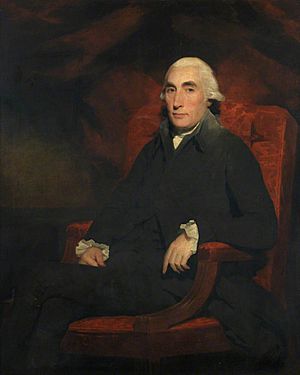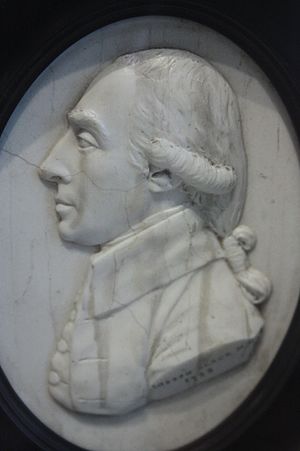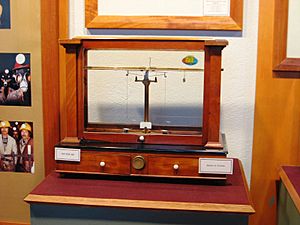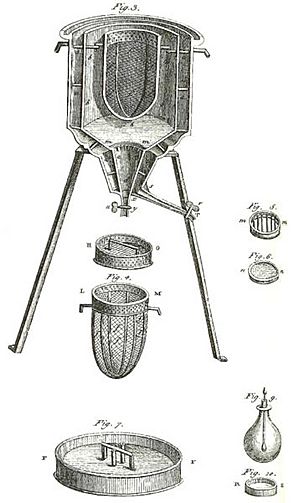Joseph Black facts for kids
Quick facts for kids
Joseph Black
|
|
|---|---|

Portrait by Sir Henry Raeburn in 1790
|
|
| Born | 16 April 1728 Bordeaux, France
|
| Died | 6 December 1799 (aged 71) Edinburgh, Scotland
|
| Nationality | Scottish |
| Alma mater | University of Glasgow University of Edinburgh |
| Known for | The discovery of Magnesium carbon dioxide Latent heat specific heat Invention of Analytical balance |
| Scientific career | |
| Fields | Medicine, physics, chemistry |
| Institutions | University of Edinburgh |
| Academic advisors | William Cullen |
| Notable students | James Edward Smith Thomas Charles Hope |
Joseph Black (born April 16, 1728 – died December 6, 1799) was an important Scottish scientist. He was a physicist and chemist. He is famous for discovering magnesium, latent heat, specific heat, and carbon dioxide.
Black taught at the University of Glasgow for ten years, starting in 1756. Later, he became a professor at the University of Edinburgh in 1766. He taught there for over 30 years. Today, the chemistry buildings at both universities are named after him.
Contents
Early Life and Education
Joseph Black was born in Bordeaux, France. He was one of twelve children. His mother's family was involved in the wine business. His father was a "factor," which means he managed business for others in the wine trade.
Joseph was homeschooled until he was 12 years old. Then he went to grammar school in Belfast. In 1746, at age 18, he started studying at the University of Glasgow. He spent four years there. After that, he studied for another four years at the University of Edinburgh. He focused on medical studies. For his final project, he wrote about treating kidney stones using a salt called magnesium carbonate.
Amazing Scientific Discoveries
Understanding Chemical Principles
In the 1700s, most scientists thought chemistry was based on five main parts: Water, Salt, Earth, Fire, and Metal. Joseph Black added a sixth part: Air. He did this after his experiments showed that carbon dioxide existed. He called it "fixed air." This helped start a new area of chemistry called pneumatic chemistry, which studies gases.
Black wanted to know how these different parts combined. He used the word affinity to describe the force that held them together. He taught his students at the University of Edinburgh how to use experiments to change these combinations.
Inventing the Analytical Balance
Around 1750, while still a student, Black created a special weighing tool. It was called the analytical balance. This balance used a lightweight beam that rested on a pointed support, called a fulcrum. Each side of the beam had a pan for placing samples or weights.
This new balance was much more accurate than any other balance of its time. It quickly became a very important tool in chemistry labs everywhere.
Discovering Latent Heat
In 1757, Joseph Black became a professor at the University of Glasgow.
In 1761, he made an important discovery about heat. He noticed that when you heat ice at its melting point, the temperature doesn't go up. Instead, the ice just turns into water. He also saw that when water boils, its temperature doesn't rise. It just turns into steam.
Black realized that the heat added was not making the temperature hotter. Instead, it was "hidden" or "latent" within the ice or boiling water. This hidden heat was used to change the state of the substance (from solid to liquid, or liquid to gas). This idea is called latent heat.
Black's theory of latent heat was a huge step forward. It helped start the study of thermodynamics, which is about how heat and energy work. He also showed that different materials need different amounts of heat to raise their temperature. This is called specific heat.
His work on latent heat was very important for the invention of the steam engine. Black became friends with James Watt around 1757. Black even helped Watt financially with his early research on steam power. Black's discoveries helped Watt improve the steam engine and make it more efficient.
Understanding Carbon Dioxide
Black also studied the properties of a gas that appeared in different chemical reactions. He found that if you heated limestone (calcium carbonate) or treated it with acids, it produced a gas. He named this gas "fixed air."
He observed that "fixed air" was heavier than regular air. It also would not allow a flame to burn or animals to live. Black also discovered that if you bubbled this gas through a solution of lime (calcium hydroxide), it would form calcium carbonate. He used this to show that "fixed air" (which we now call carbon dioxide) is produced when animals breathe and when things ferment.
Life as a Professor
In 1766, Joseph Black moved to the University of Edinburgh. He took over from his friend and former teacher, William Cullen, as the Professor of Medicine and Chemistry.
From this point on, Black focused mostly on teaching. He stopped doing as much research. He was a very popular teacher. More and more students came to his lectures every year for over thirty years. His lectures made chemistry popular, and attending them even became a fashionable activity!
Black was known as one of the best lecturers at the University. His chemistry classes always had a huge number of students. Many students even took his class two or three times. He always included new and exciting topics. He also chose experiments that looked amazing. Black used many different teaching methods to make chemistry easy to understand for his students, some of whom were as young as 14.
Students came from all over the United Kingdom, its colonies, and Europe. Hundreds of them wrote down his lectures in their notebooks. They then shared his ideas after they left the university.
On November 17, 1783, he helped create the Royal Society of Edinburgh. He was also the President of the Royal College of Physicians of Edinburgh from 1788 to 1790. Black helped revise the college's medicine guide, the Edinburgh Pharmacopoeia. He was also appointed the main doctor to King George III in Scotland.
Black's health started to get worse, which reduced his research and teaching. From 1793, he slowly stopped his teaching duties. In 1795, Charles Hope was appointed to help him with his professorship. Black gave his last lecture in 1797.
Personal Life

Joseph Black was a member of a group called The Poker Club. He was a close friend and cousin to Adam Ferguson, another important Scottish thinker. He was also friends with famous people like David Hume, Adam Smith, and other thinkers of the Scottish Enlightenment. He was also close to the pioneering geologist James Hutton.
Black never married. He died peacefully at his home in Edinburgh in 1799. He was 71 years old. He is buried in Greyfriars Kirkyard.
In 2011, scientists found some old equipment believed to belong to Black. They found it during an archaeological dig at the University of Edinburgh.
Images for kids
See also
 In Spanish: Joseph Black para niños
In Spanish: Joseph Black para niños
- Calorimetry
- Heat
- Pneumatic chemistry
- Thermochemistry







